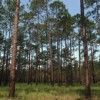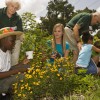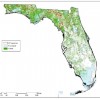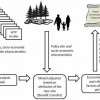 Payments for sequestering carbon in forests can be an important supplemental income source in the southern US which includes one-third of the contiguous US forest carbon stocks and supplies 16% of the world’s wood. It is difficult to understand the carbon market and certification options available to Florida forest landowners and the possible risks of participating in them. To address this need, UF/IFAS forest management specialists provide this overview of forest carbon markets in the United States as of 2014 and compare key features of the four major carbon offset certification options. This 9-page fact sheet was written by José R. Soto, Francisco J. Escobedo, and Damian C. Adams, and published by the UF Department of School of Forest Resources and Conservation, July 2014.
Payments for sequestering carbon in forests can be an important supplemental income source in the southern US which includes one-third of the contiguous US forest carbon stocks and supplies 16% of the world’s wood. It is difficult to understand the carbon market and certification options available to Florida forest landowners and the possible risks of participating in them. To address this need, UF/IFAS forest management specialists provide this overview of forest carbon markets in the United States as of 2014 and compare key features of the four major carbon offset certification options. This 9-page fact sheet was written by José R. Soto, Francisco J. Escobedo, and Damian C. Adams, and published by the UF Department of School of Forest Resources and Conservation, July 2014.
http://edis.ifas.ufl.edu/fr387
Tag: Damian Adams
Florida Forest Landowner Preferences for Carbon Offset Program Characteristics
 This 7-page fact sheet explains how carbon-offset programs operate and examines their benefits to landowners and the environment, especially in Florida and the southeast US. A summary of a recent study of Florida forest landowners is used to better reveal views on forest carbon-offset programs and their willingness-to-accept monetary compensation for their enrollment in such programs. Written by José R. Soto, Damian C. Adams, and Francisco J. Escobedo, and published by the UF Department of School of Forest Resources and Conservation, July 2014.
This 7-page fact sheet explains how carbon-offset programs operate and examines their benefits to landowners and the environment, especially in Florida and the southeast US. A summary of a recent study of Florida forest landowners is used to better reveal views on forest carbon-offset programs and their willingness-to-accept monetary compensation for their enrollment in such programs. Written by José R. Soto, Damian C. Adams, and Francisco J. Escobedo, and published by the UF Department of School of Forest Resources and Conservation, July 2014.
http://edis.ifas.ufl.edu/fr388
Socio-Demographic Characteristics and Concerns about Water Quality Issues of Master Gardener Program Volunteers
 To respond to residents’ informational needs, the Cooperative Extension Service offers a variety of volunteer training and certification programs. Who participates in such programs? What types of audiences are being reached? Do such programs increase knowledge and change behavior of the volunteers? In this article, we attempt to answer these questions by summarizing existing studies and using responses to a regional public survey, and by focusing on the Master Gardener program and surface water quality issues as examples. This 7-page fact sheet was written by Tatiana Borisova, Michael Smolen, Maria Pilar Useche, Jon Calabria, Nickola Sochacka, Damian Adams, Diane Boellstorff, Jason Evans, and Robert Mahler, and published by the UF Department of Food and Resource Economics, May 2014.
To respond to residents’ informational needs, the Cooperative Extension Service offers a variety of volunteer training and certification programs. Who participates in such programs? What types of audiences are being reached? Do such programs increase knowledge and change behavior of the volunteers? In this article, we attempt to answer these questions by summarizing existing studies and using responses to a regional public survey, and by focusing on the Master Gardener program and surface water quality issues as examples. This 7-page fact sheet was written by Tatiana Borisova, Michael Smolen, Maria Pilar Useche, Jon Calabria, Nickola Sochacka, Damian Adams, Diane Boellstorff, Jason Evans, and Robert Mahler, and published by the UF Department of Food and Resource Economics, May 2014.
http://edis.ifas.ufl.edu/fe942
Public Land Management Agencies’ and Nonindustrial Private Forest Landowners’ Perceptions towards Ecosystem Services
 The state of Florida has more than 16 million acres of forestland. From clean air to pulp for paper to aesthetic landscapes, humans benefit from private and public forests in many different ways. However, small private landowners and public land management agencies manage the majority of this land, and it is up to these people to decide how society will benefit from those forests. This paper uses the concept of ecosystem services to explore the reasons why public land management agencies and private landowners manage their forests. This 5-page fact sheet was written by Taylor Stein, Namyun Kil, Alexis Frank, Alison E. Adams, Damian C. Adams, and Francisco J. Escobedo, and published by the UF Department of School of Forest Resources and Conservation, July 2013.
The state of Florida has more than 16 million acres of forestland. From clean air to pulp for paper to aesthetic landscapes, humans benefit from private and public forests in many different ways. However, small private landowners and public land management agencies manage the majority of this land, and it is up to these people to decide how society will benefit from those forests. This paper uses the concept of ecosystem services to explore the reasons why public land management agencies and private landowners manage their forests. This 5-page fact sheet was written by Taylor Stein, Namyun Kil, Alexis Frank, Alison E. Adams, Damian C. Adams, and Francisco J. Escobedo, and published by the UF Department of School of Forest Resources and Conservation, July 2013.
http://edis.ifas.ufl.edu/fr380
The Green Value of Your Woods: A Summary of Ecosystem Services Provided by Forest Stewardship Lands in Florida
 Lands enrolled in voluntary forest management and conservation programs, like the Forest Stewardship Program, promote good land management practices. In addition to benefiting the landowners enrolled in these programs, good land management provides ecosystem services to society. The Stewardship Ecosystem Services Survey calculated the physical and economic benefits of water resource protection, carbon sequestration and storage, timber production, and wildlife conservation. This 2-page fact sheet was written by Rose Godfrey, Chris Demers, Francisco Escobedo, Damian Adams, and Michael Andreu, and published by the UF Department of School of Forest Resources and Conservation, September 2013.
Lands enrolled in voluntary forest management and conservation programs, like the Forest Stewardship Program, promote good land management practices. In addition to benefiting the landowners enrolled in these programs, good land management provides ecosystem services to society. The Stewardship Ecosystem Services Survey calculated the physical and economic benefits of water resource protection, carbon sequestration and storage, timber production, and wildlife conservation. This 2-page fact sheet was written by Rose Godfrey, Chris Demers, Francisco Escobedo, Damian Adams, and Michael Andreu, and published by the UF Department of School of Forest Resources and Conservation, September 2013.
http://edis.ifas.ufl.edu/fr381
Valuing the Ecosystem Services of Florida‹s Forest Conservation Programs: The Economic Benefits of Protecting Water Quality (FOR309/FR377)
 How much are Floridians willing to pay for water quality protection programs that include forest conservation? This 9-page fact sheet reports the results of a study to answer this question, using a benefit transfer approach. Written by Melissa M. Kreye, Francisco J. Escobedo, Damian C. Adams, Taylor Stein, and Tatiana Borisova, and published by the UF Department of School of Forest Resources and Conservation, April 2013.
How much are Floridians willing to pay for water quality protection programs that include forest conservation? This 9-page fact sheet reports the results of a study to answer this question, using a benefit transfer approach. Written by Melissa M. Kreye, Francisco J. Escobedo, Damian C. Adams, Taylor Stein, and Tatiana Borisova, and published by the UF Department of School of Forest Resources and Conservation, April 2013.
http://edis.ifas.ufl.edu/fr377
Public Opinion about Water Availability (FE845)
 This 8-page fact sheet summarizes results of a public survey about Florida water resources. The respondents were asked about the quantity of water in their area, water availability in ten years, the likelihood of prolonged drought, and the effect of climate change on rainfall. Written by Tatiana Borisova and Damian Adams, and published by the UF Department of Food and Resource Economics, March 2012.
This 8-page fact sheet summarizes results of a public survey about Florida water resources. The respondents were asked about the quantity of water in their area, water availability in ten years, the likelihood of prolonged drought, and the effect of climate change on rainfall. Written by Tatiana Borisova and Damian Adams, and published by the UF Department of Food and Resource Economics, March 2012.
http://edis.ifas.ufl.edu/fe845
Economic Value of Upland Invasive Plant Management in Florida State Parks (FOR290/FR352)
 Invasive plants are a serious problem for Florida’s natural areas, but what is the impact of their management on the economic value of our state parks? This 6-page fact sheet reports the results of a survey of Florida residents to determine how much they would pay for lower levels of invasive plant coverage in parks they visit, and estimate the value of invasive plant control. Written by Damian C. Adams, Anafrida N. Bwenge, Donna J. Lee, Sherry L. Larkin, and Janaki R. R. Alavalapati, and published by the UF Department of School of Forest Resources and Conservation, October 2011.
Invasive plants are a serious problem for Florida’s natural areas, but what is the impact of their management on the economic value of our state parks? This 6-page fact sheet reports the results of a survey of Florida residents to determine how much they would pay for lower levels of invasive plant coverage in parks they visit, and estimate the value of invasive plant control. Written by Damian C. Adams, Anafrida N. Bwenge, Donna J. Lee, Sherry L. Larkin, and Janaki R. R. Alavalapati, and published by the UF Department of School of Forest Resources and Conservation, October 2011.
http://edis.ifas.ufl.edu/fr352
FE851 Use, Perceptions, and Barriers to Water Conservation Strategies for Florida Water Utilities
FE851, an 18-page illustrated report by Shirish Rajbhanary, Tatiana Borisova, Damian Adams, Dwayne Haynes, and Chris Boyer, presents the results of a 2009–2010 survey of representatives of Florida’s drinking water systems to examine the relative use of conservation strategies by Florida water utilities. Includes references. Published by the UF Department of Food and Resource Economics, September 2010.
http://edis.ifas.ufl.edu/fe851
FE811 Balancing Urban Water Demand and Supply in Florida: Overview of Tools Available to Water Managers
FE811, a 10-page fact sheet by Tatiana Borisova, Colin Rawls, and Damian Adams, discusses alternative strategies that can be used by water utility managers to balance water demand and supply in the residential sector. Includes references. Published by the UF Department of Food and Resource Economics, October 2009.
http://edis.ifas.ufl.edu/FE811